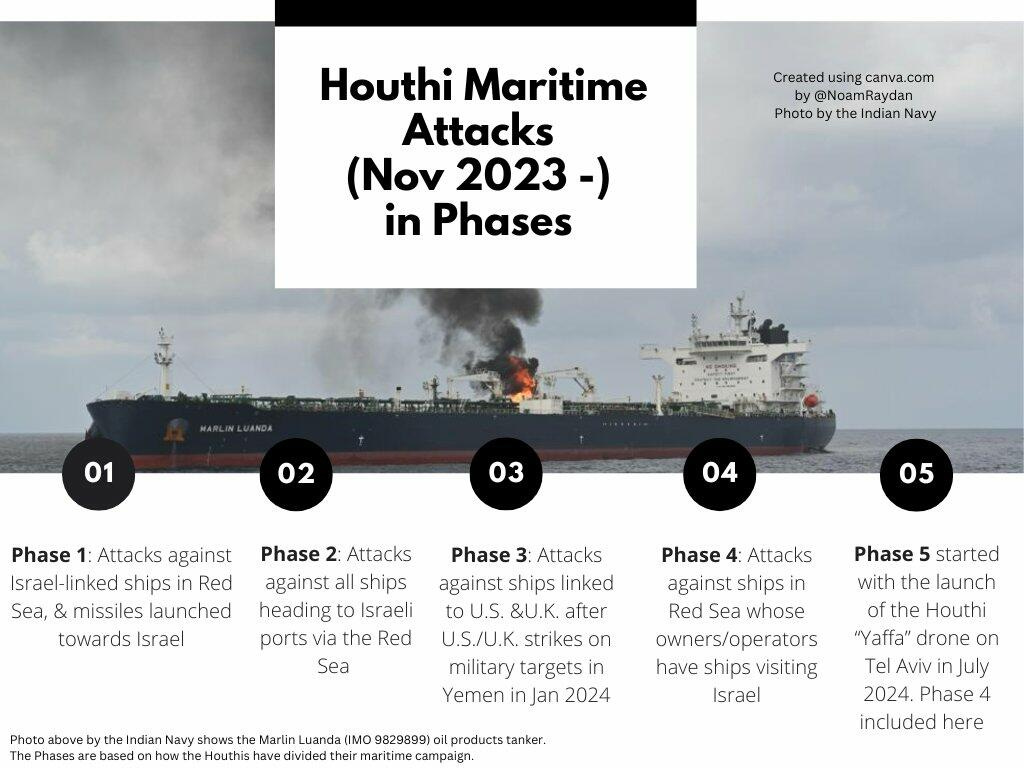Red Sea Crisis: Footage Captures Supermax Tanker Explosion After Houthi Missile Strike As West Fails To Secure Chokepoint
"Phase 4" of their maritime campaign has been more lethal.
Red Sea Crisis: Footage Captures Suezmax Tanker Explosion After Houthi Missile Strike As West Fails To Secure Chokepoint
BY TYLER DURDEN
SATURDAY, AUG 24, 2024 - 12:40 PM
Western nations, led by the US and ones across Europe, with the most modern warship fleets, seem absolutely powerless to stop Iran-backed Houthi rebels from launching missile and drone strikes on merchant vessels in the southern Red Sea and Gulf of Oman (maybe because it's an election year in the US).
The US and EU have launched numerous military operations committed to ensuring freedom of navigation and maritime security in the highly contested region but have failed repeatedly.
The latest failure by the West comes earlier this week after a missile attack bombarded Greek-flagged oil tanker MV Sounion about 77 nautical miles west of the Yemeni port of Hodeidah, forcing at least one EU warship to rescue the crew of the Suezmax tanker—the largest type of oil tanker capable of transiting the Suez Canal.
Here are our reports on the maritime incident:
On Thursday, EUNAVFOR ASPIDES, the European Union's military operation committed to ensuring freedom of navigation and maritime security in the Red Sea, warned Sounion was set on fire and carrying 150,000 tons of crude and now "represents a navigational and environmental hazard."
Fast forward to Friday, when reports from the Financial Times and Reuters say Houthi rebels blew up the oil tanker.
Dramatic video of the explosion was uploaded on x.
Reuters quoted Houthi military spokesman Yahya Saree in a televised speech, that said the tanker "belongs to a company that has ties to the Israeli enemy and violated the ban decision of entry to the ports of occupied Palestine."
"The blowing up of the ship marks a new tactic for the Houthis. Since the group began its campaign against international shipping last November, it has sunk two ships — the Rubymar, attacked in February, and the Tutor, attacked in June," Financial Times noted.
Maritime expert Noam Raydan, and author of The Chokepoint, provided a detailed update on the situation in the Red Sea:
As another crude oil tanker connected to Delta Tankers was attacked this week in the southern Red Sea, I was keeping my eye on some tankers linked to transporting Russian oil, previously attacked by the Houthis due to past links to a UK-based company, and which returned to sail in the Red Sea despite experiencing ASBM attacks in March and April. I selected two specific tankers for my piece, partly because they are not in the region now, including an EU-sanctioned tanker.
When the Houthis attacked the two tankers in the past months, the Yemeni group referred to them as "British" ships based on outdated information. Despite the attacks, the vessels sailed recently in the region. So, why do some Russia-linked tankers continue on their route (and some don't even turn off AIS in a risky area) following a Houthi attack, while other tankers' owners or operators avoid the Gulf of Aden/southern Red Sea route and instead sail around southern Africa?
Raydan continued:
There has been a focus this week on the aggressiveness of the Houthis and the nature of the attacks against two commercial vessels. But if you've been tracking how such attacks have been evolving over the past months, you'd know there's nothing surprising here. The Houthi agenda is clear, and they've shown that they are willing to sink ships that fit their "list of targets" (even if the vessels are carrying cargoes from regional countries, like Iraq), and harm seafarers. "Phase 4" of their maritime campaign has been more lethal.
The journey of the recent tanker attacked in the Red Sea, Sounion (IMO 9312145), was very risky, and the owner/operator knows that (will leave it at that for X). The tanker, based on an image of the ship from 2023, and the one published by the French military, @FFEAU_ALINDIEN yesterday, showed that the Sounion had the name Delta Tankers even painted on the hull side- meaning the tanker/company was easily recognizable at sea. And the tanker was being approached by small crafts. This comes after two other Delta Tankers-connected vessels were attacked earlier this month in the Red Sea.
UKMTO reported today that "three fires have been observed" on the Sounion ( crew rescued already) and the vessel "appears" to be drifting. The Houthis claimed responsibility for the fires in a video published on Telegram today. The Sounion is carrying Iraqi oil cargo loaded in Basrah earlier this month.
Note that such attacks on oil tankers don't halt supply. They affect the shorter route some tankers prefer to take to get to their destination. Meaning oil is flowing- if it cannot get through the Red Sea to Europe for instance, a vessel takes the Cape route. Iraq as an example: Oil shipments to Europe are being delivered via Suez and the Cape route, but more has been moving via the Cape this year. We are not seeing attacks on energy facilities that greatly affect output or exports.
She added:
"Some keep asking why the Houthis are attacking those commercial vessels. The Yemeni group has an agenda, and they have divided their maritime campaign into five phases so far, and they've been following it. I summarize below the phases based on statements from the group, and a televised speech by their leader."
To put it in perspective, Sounion is hauling 150,000 tons of crude—a little more than four times the amount spilled by the Exxon Valdez in 1989. This raises the alarming possibility of a major environmental disaster in the Red Sea, as Western militaries struggle to ensure freedom of navigation and maritime security in this critical maritime chokepoint.
https://www.zerohedge.com/commodities/suezmax-tanker-explodes-after-houthi-missile-strike-amid-red-sea-crisis-west-fails




